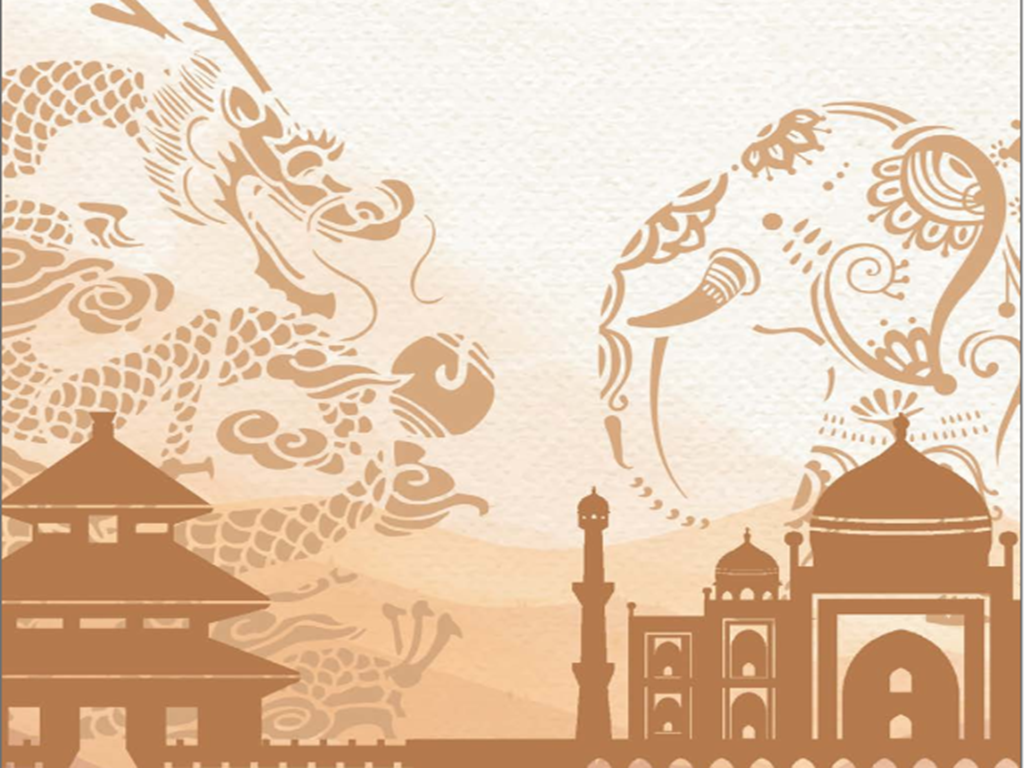Memorabilia of 75th Anniversary of the Establishment of Diplomatic Relations between India and China

On April 1, 1950, China and India established diplomatic relations. India was the first non-socialist country to establish relations with the People’s Republic of China. “Hindi Chini Bhai Bhai” has become a catchphrase from that time and a much-told story in the history of bilateral exchanges.
In 1954, Chinese Premier Zhou Enlai visited India. China and India signed a joint statement and advocated the Five Principles of Peaceful Coexistence. In the same year, Indian Prime Minister Jawaharlal Nehru visited China. He was the first head of government of a non-socialist country who visited China since the founding of the People’s Republic of China in 1949.
In 1955, Chinese Premier Zhou Enlai and Indian Prime Minister Jawaharlal Nehru attended the Asian-African Conference in which 29 countries participated in Bandung, Indonesia and jointly advocated the Bandung Spirit of solidarity, friendship and cooperation.
In 1962, the border conflict led to a serious setback in bilateral relations.
In 1976, China and India resumed ambassadorial ties and bilateral relations improved gradually.
In 1988, Indian Prime Minister Rajiv Gandhi visited China, initiating the process of normalization of bilateral relations. The two sides agreed to “look forward” and develop bilateral relations actively in other fields while seeking a mutually acceptable solution to the boundary question.
In 1991, Chinese Premier Li Peng visited India. The mutual visits by heads of government of the two countries were restored after decades of suspension.
In 1992, Indian President Ramaswamy Venkataraman visited China. He was the first president who visited China since the independence of the Republic of India.
In 1993, Indian Prime Minister Narasimha Rao visited China. Agreement between the Government of China and the Government of India on the Maintenance of Peace and Tranquility along the Line of Actual Control in the India-China Border Areas was signed.
In 1996, Chinese President Jiang Zemin visited India. He was the first head of state from China who visited India since the establishment of bilateral ties. Both sides agreed to build a constructive partnership of cooperation oriented towards the 21st century. Agreement between the Government of China and the Government of India on Confidence Building Measures in the Military Field along the Line of Actual Control in the India-China Border Areas was signed.
In 2000, Indian President Kocheril Raman Narayanan visited China on the occasion of the 50th anniversary of the establishment of diplomatic ties between the two countries.
In 2002, Chinese Premier Zhu Rongji visited India. Both sides agreed to enhance mutual understanding and trust and promote exchange and cooperation in various fields.
In 2003, Indian Prime Minister Atal Bihari Vajpayee visited China. The two sides signed The Declaration on the Principles and Comprehensive Cooperation in China-India Relations, and agreed to establish the special representatives meeting mechanism on the India-China boundary question.
In 2005, Chinese Premier Wen Jiabao visited India. China and India signed a joint statement and declared the establishment of the strategic and cooperative partnership for peace and prosperity. The two sides welcomed signing of the Agreement on the Political Parameters and Guiding Principles for the Settlement of the India-China Boundary Question.
In 2006, Chinese President Hu Jintao visited India. The two sides signed a joint declaration to formulate the ten-pronged strategy for deepening the strategic and cooperative partnership.
In 2008, Indian Prime Minister Manmohan Singh visited China. A Shared Vision for the 21st Century was agreed upon by the two sides.
In 2010, Indian President Pratibha Devisingh Patil visited China in May for the 60th anniversary of the establishment of diplomatic ties between China and India. In December, Chinese Premier Wen Jiabao visited India and the two sides issued a joint communiqué.
2011 was designated as the Year of China-India Exchange. Both sides held a series of people-to-people and cultural exchange activities, and signed a memorandum on joint compilation for the “Encyclopedia of India-China Cultural Contacts.” A 500-member Indian youth delegation visited China.
2012 was declared as the Year of China-India Friendship and Cooperation. Chinese President Hu Jintao and Chinese Premier Wen Jiabao met with Indian Prime Minister Manmohan Singh respectively on the sidelines of the 4th BRICS Summit and the United Nations Conference on Sustainable Development. A 500-member Chinese youth delegation visited India.
In 2013, Chinese President Xi Jinping met with Indian Prime Minister Manmohan Singh on the sidelines of the 5th BRICS Summit in Durban, South Africa in March. Chinese Premier Li Keqiang visited India in May and the two sides released a joint statement. Indian Prime Minister Manmohan Singh visited China in October.
2014 was designated as the Year of China-India Friendly Exchange. In September, Chinese President Xi Jinping paid a state visit to India and visited Indian Prime Minister Narendra Modi’s home state of Gujarat. The two sides issued the Joint Statement on Building a Closer Developmental Partnership. In the same year, Chinese President Xi Jinping and Chinese Premier Li Keqiang met with Indian Prime Minister Narendra Modi respectively on the sidelines of the 6th BRICS Summit and the Leaders’ Meetings on East Asia Cooperation in Myanmar.
In 2015, Indian Prime Minister Narendra Modi visited China and went to Xi’an, capital of Chinese President Xi Jinping’s home province Shaanxi. In the same year, Chinese President Xi Jinping and Chinese Premier Li Keqiang met with Indian Prime Minister Narendra Modi respectively on the sidelines of the 7th BRICS Summit in Ufa and the Leaders’ Meetings on East Asia Cooperation in Malaysia. China decided to open the Nathu La Pass to Indian official pilgrims to Xizang. India celebrated the India Tourism Year in China.
In 2016, Indian President Pranab Kumar Mukherjee visited China. Indian Prime Minister Narendra Modi visited China to attend the G20 Summit in Hangzhou and met with Chinese President Xi Jinping on the sidelines. Chinese President Xi Jinping visited India to participate in the 8th BRICS Summit in Goa and met with Indian Prime Minister Narendra Modi on the sidelines. China celebrated China Tourism Year in India.
In 2017, Chinese President Xi Jinping met with Indian Prime Minister Narendra Modi on the sidelines of the SCO Summit in Astana. Indian Prime Minister Narendra Modi visited China to attend the 9th BRICS Summit in Xiamen and met with Chinese President Xi Jinping on the sidelines.
In 2018, Chinese President Xi Jinping held an informal meeting with Indian Prime Minister Narendra Modi in Wuhan. They had in-depth discussions and reached broad consensus on the overarching, long-term and strategic issues of global and bilateral importance and their respective visions for national development as well as domestic and foreign policies. The informal meeting set up a new model of exchanges between two leaders and became a milestone in the history of bilateral relations. In the same year, Indian Prime Minister Narendra Modi visited China to attend the SCO Summit in Qingdao and met with Chinese President Xi Jinping on the sidelines. The two leaders met again on the sidelines of the 10th BRICS Summit and the G20 Summit in Buenos Aires later in the year.
In 2019, Chinese President Xi Jinping and Indian Prime Minister Narendra Modi held the second informal meeting in Chennai, reaffirmed the Wuhan consensus and agreed to build a closer partnership for development, enhance the in-depth strategic communication, promote mutually beneficial cooperation in various fields, and advance exchanges and mutual learning between the two civilizations. In the same year, Chinese President Xi Jinping met with Indian Prime Minister Narendra Modi on the sidelines of the SCO Summit in Bishkek and the 11th BRICS Summit.
2020 marks the year of the 70th anniversary of the establishment of diplomatic relations between China and India. It is also China-India Year of Cultural and People-to-People Exchanges. The two sides agreed to hold 70 celebratory activities to demonstrate the historic connection between the two civilizations as well as their growing bilateral relationship over the years, and further deepen people-to-people exchange between the two countries at all levels, including legislatures, businesses, academics, cultural and youth organizations as well as the defense forces.
In 2021, India’s trade with China reached US$125.6 billion, witnessing a year-on-year increase of about 43 percent, crossing US$100 billion mark for the first time. The economic and trade cooperation between the two countries registers strong resilience and huge potential.
In 2024, Chinese President Xi Jinping met with Indian Prime Minister Narendra Modi on the margins of the BRICS Summit held in Kazan, Russia. This was the first bilateral meeting between the two leaders since their meeting on the sidelines of the 2019 BRICS Summit in Brasilia. The meeting was constructive and significant, with both leaders emphasizing the importance of harmony and cooperation between the two nations — home to combined 2.8 billion people. Chinese President Xi Jinping stressed that China-India relations are essentially a question of how the two large developing countries and neighbors, each with a 1.4-billion-strong population, treat each other. Development is now the biggest shared goal of China and India. Indian Prime Minister Narendra Modi noted that maintaining steady growth of India-China relations is critical to the two countries and peoples. It not only concerns the well-being and future of 2.8 billion people, but also carries great significance for peace and stability of the region and even the world at large.
2025 marks the year of the 75th anniversary of the establishment of diplomatic relations between China and India. The two countries agree to hold a series of people-to-people and cultural exchange activities this year.
